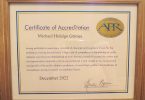Last week, I had the honor and privilege of pinning the APR pin on the two newest Accredited members of the Oklahoma City PRSA Chapter. Shortly after the monthly luncheon, which was the platform for that presentation, I met with the dean and associate dean of my college on another issue. But the conversation started with my sharing what I was doing as Accreditation chair for the Chapter.
As Dean Foote often does, he started peppering me with questions about the rigor and validity of the APR process and the Examination. It was a unique opportunity to explain Accreditation to someone who knew nothing about it, and it occurred to me that a review of that conversation might be useful to this forum, especially given the recent focus on the subject.
While Accreditation might not have all the rigor of the process lawyers and CPAs go through, I think it stacks up reasonably well. As I told the dean, I see APR as the professional development step between a bachelor’s degree and a master’s. The knowledge, skills and abilities that are studied and assessed during the APR process cover the full gambit of competencies that are the hallmark of professionalism in public relations. The process requires candidates to commit to a significant amount of study in order to successfully demonstrate their mastery of the material in both the oral Readiness Review and the computer-based Examination.
Mention of the Examination brought us to a discussion of the rigor and validity of the Examination. I mentioned that the development of the Examination was a rigorous, complex, multi-year effort that began with an analysis of the professional practice involving subject matter experts from the practice and academe to define the competencies that a public relations professional must possess to perform at the highest level. More subject matter experts determined which competencies are required in the five-to-seven-year range of a professional’s career. Other experts spent a considerable amount of time testing and refining the Examination questions to ensure they were both rigorous and tested the material they were intended to test. The result, I told the dean, is an Examination that is not only reliable and valid, but that can differentiate those candidates who have attained professional mastery from those who haven’t. I also noted that many other professional organizations base their certification process on multiple-choice testing, including CPAs.
Finally, I observed that APR is gaining traction not just in the minimum requirements for more and more jobs, but in the professional development expectations for more and more organizations. As an example, I told the dean that the corporate communication departments of two major energy companies in Oklahoma City set as yearly goals for their employees the attainment of Accreditation. In fact, one of the newly Accredited members to whom I presented the APR pin was from one of those companies.
By the end of the conversation, I believe the dean agreed with me that the Accreditation process stacked up well against the process lawyers and CPAs went through in their professions. I hope you agree that it does, as well, and encourage you to take the plunge if you have not already.
Capt. Robert Pritchard, APR, Fellow PRSA, is a member of the public relations faculty of the Gaylord College of Journalism and Mass Communication at the University of Oklahoma. He has more than 25 years’ experience as a public relations officer in the U.S. Navy, and ten years’ experience as a public relations educator. He is the faculty adviser for Lindsey + Asp, the student-operated advertising and public relations agency at Gaylord, and for the OU PRSSA Chapter. He is also the 2011-2013 PRSSA National Faculty Adviser.






